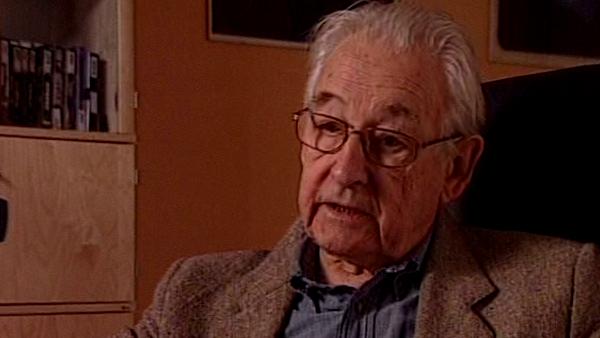NEXT STORY

The army in Suwałki
RELATED STORIES

NEXT STORY

The army in Suwałki
RELATED STORIES


|
Views | Duration | |
|---|---|---|---|
| 1. The beginning | 1 | 1814 | 03:12 |
| 2. Polish Army before World War II | 481 | 01:54 | |
| 3. The army in Suwałki | 284 | 01:59 | |
| 4. My father | 306 | 01:03 | |
| 5. The Wajda Family | 292 | 04:42 | |
| 6. Signing up to join the Home Army | 187 | 04:40 | |
| 7. Cultural life in war-time Kraków | 156 | 03:19 | |
| 8. First contact with the world of art | 167 | 05:11 | |
| 9. What we knew about the Soviets | 232 | 01:45 | |
| 10. My mother | 182 | 02:44 |

My father was an officer. When he was 16 years old, he joined the Legions after which he was imprisoned in Szczypiorno. He remained in the army after that, and then in 1920 he defended Lwów, fought in the battle for Przemyśl and met my mother there. Then my father was transferred to Suwałki, to the garrison of the 41st Infantry Regiment; all I can see in my mind's eye are barracks. Because we always lived close to the barracks. The children used to play in the barracks, and these barracks, the army are the things I remember the best. That army was very like a 19th century army. My father commanded a platoon of armed cavalry. If you consider that one platoon of armed cavalry had three cannons, and during the war each platoon was made up of 4,000 men, this means that for every 4,000 soldiers there were three field cannon. How weak their fire power was. There was a platoon of machine guns and a liaison platoon. This army was of course being formed and modernised, but because of the poverty that affected Poland in the interwar years, this army reflected the country's economic potential. Therefore, I saw the cavalry, I saw an army that probably resembled a 19th century army - always on foot.
Mój ojciec był oficerem... jako szesnastoletni chłopiec z gimnazjum poszedł do Legionów, potem był internowany w Szczypiornie, potem już został w armii, potem w '20 roku był obrońcą Lwowa, walczył o Przemyśl, gdzie poznał matkę... Potem ojca przenieśli do Suwałk do garnizonu, do 41. Pułku Piechoty... i to, co widzę przed oczami, to są przede wszystkim zawsze koszary, no bo zawsze mieszkaliśmy blisko koszar. Dzieci się bawiły w koszarach i te koszary, wojsko – to są te obrazy, które najlepiej pamiętam. I ta armia bardzo przypominała właśnie jakąś armię XIX-wieczną. Ojciec mój był dowódcą plutonu artylerii konnej. Jeżeli się pomyśli, że w plutonie artylerii konnej były trzy działa, a pułk składał się w czasie wojny... miał stan około czterech tysięcy ludzi, to znaczy, że na cztery tysiące żołnierzy były trzy działa polowe. Jaka to była słaba, że tak powiem, siła ognia. Był pluton karabinów maszynowych ciężkich, pluton łączności. Ta armia oczywiście się tworzyła, modernizowała się, no ale przy tym biednym kraju jakim była Polska w okresie miedzywojennym ta armia... no, była odwzorowaniem, że tak powiem, możliwości ekonomicznych. Tak że widziałem armię konną, widziałem armię, która przypominała pewnie jeszcze armie XIX-wieczne idące pieszo.
Polish film director Andrzej Wajda (1926-2016) was a towering presence in Polish cinema for six decades. His films, showing the horror of the German occupation of Poland, won awards at Cannes and established his reputation as both story-teller and commentator on Poland's turbulent history. As well as his impressive career in TV and film, he also served on the national Senate from 1989-91.
Title: Polish Army before World War II
Listeners: Jacek Petrycki
Cinematographer Jacek Petrycki was born in Poznań, Poland in 1948. He has worked extensively in Poland and throughout the world. His credits include, for Agniezka Holland, Provincial Actors (1979), Europe, Europe (1990), Shot in the Heart (2001) and Julie Walking Home (2002), for Krysztof Kieslowski numerous short films including Camera Buff (1980) and No End (1985). Other credits include Journey to the Sun (1998), directed by Jesim Ustaoglu, which won the Golden Camera 300 award at the International Film Camera Festival, Shooters (2000) and The Valley (1999), both directed by Dan Reed, Unforgiving (1993) and Betrayed (1995) by Clive Gordon both of which won the BAFTA for best factual photography. Jacek Petrycki is also a teacher and a filmmaker.
Tags: Legions, 41st Infantry Regiment, Szczypiorno, Przemyśl, Lvov, Suwałki
Duration: 1 minute, 54 seconds
Date story recorded: August 2003
Date story went live: 24 January 2008